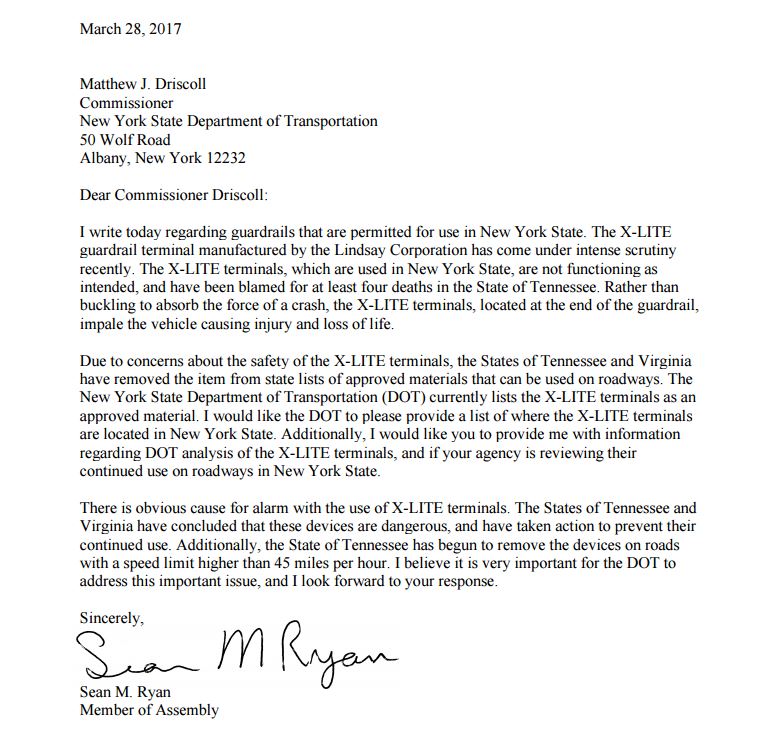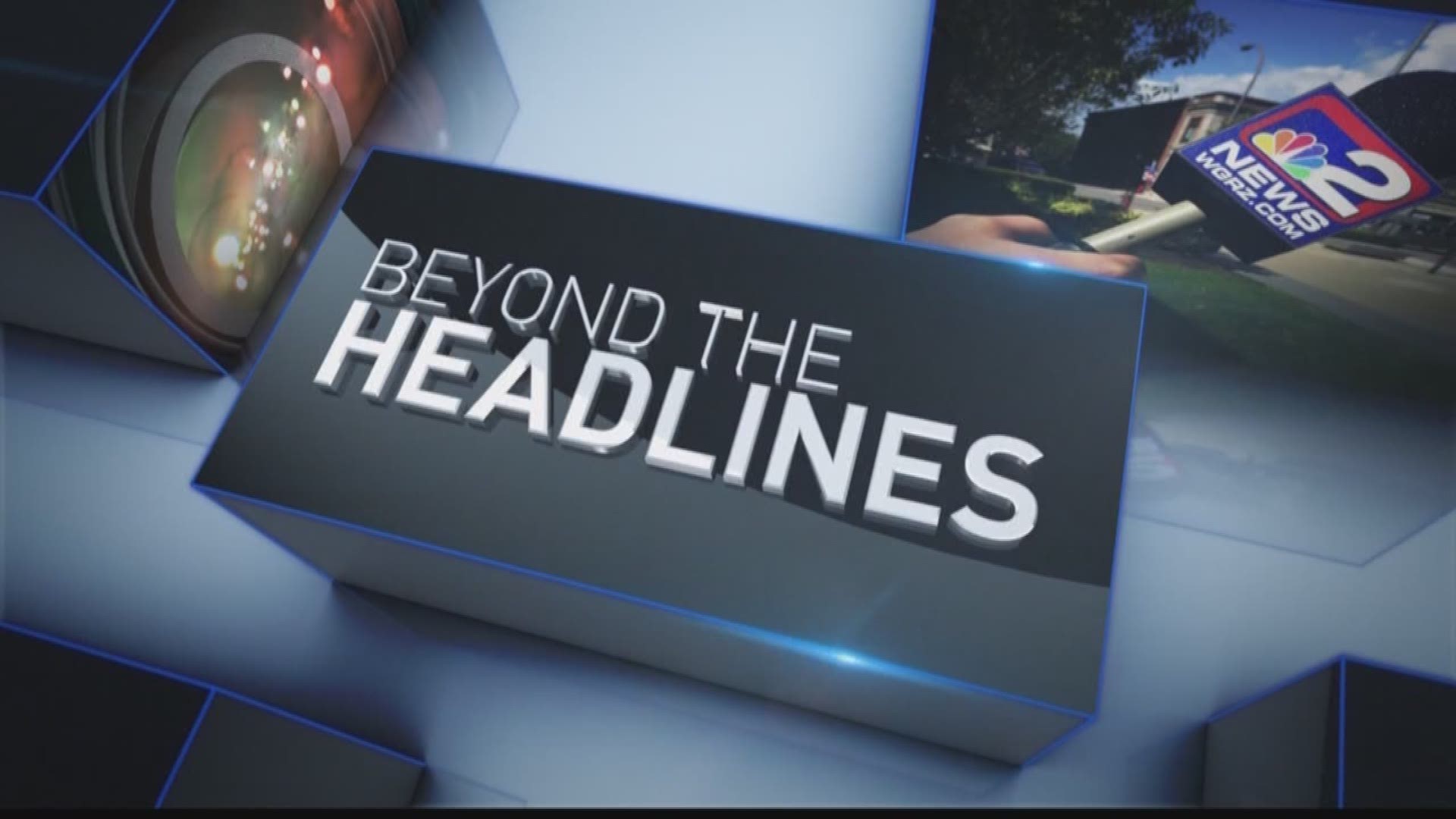This article has been updated to reflect new legislation filed in the New York State Legislature. Lindsay Corporation has also issued an additional statement about its guardrail devices.
BUFFALO, N.Y. – Five months ago, on a Tuesday morning in November, 17-year-old Hannah Eimers was driving her father’s Volvo on Interstate 75 in East Tennessee. Heading northeast toward Knoxville, Eimers’ car veered off the road around 5:45 a.m., crashing into the end of a guardrail.
Intended as a safety device, that guardrail end terminal instead killed Eimers on impact, according to her father, Stephen.
Hannah’s sudden passing left a mark not only in Tennessee, but also 700 miles away in Western New York, where several of her family members still live. Hannah was born in Fredonia, but she spent most of her life in Tennessee after her family moved to the Knoxville area in 2001.
Multiple Tennessee news outlets covered the original accident and the aftermath of the tragedy, but the story gained heightened national attention this week when it was discovered the Tennessee Department of Transportation accidentally billed the Eimers family for the cost of the guardrail end terminal that killed their daughter.
Receiving that erroneous bill in the mail was traumatizing, Stephen Eimers said, but he’d like to use the national spotlight to focus on the fact that the guardrail end device on Interstate 75 should never have been on the road in the first place.
And it’s possible, too, the device could be on the roads in Hannah’s native state of New York, where the State Department of Transportation lists the same model as an approved piece of equipment for contractors.
“This is an extraordinarily dangerous device, and it needs to come off our roadways,” Eimers said, speaking on the phone from Tennessee. “It needs to come off our roadways now.”
This specific device on Interstate 75 in Tennessee was known as the “X-LITE” terminal, developed by a Nebraska-based company named Lindsay Corporation. One week before Hannah’s death, the Tennessee Department of Transportation had removed Lindsay’s X-LITE model from its list of approved materials for contractors, citing “concerns about potential long term performance issues associated with the telescoping w-beam, slider assembly friction reduction type system,” according to a statement sent to 2 On Your Side by TDOT spokesperson Mark Nagi.
WBIR-TV in Knoxville reported Tuesday the X-LITE device has been involved in at least four fatal crashes in Tennessee.
After analyzing crash data, TDOT decided to take further action on the X-LITE terminal. Soon, they will begin removing the devices on roads with a speed limit higher than 45 miles per hour.
In September, the state of Virginia also issued an internal notice, announcing it had removed the X-LITE device from their approved list of equipment as well.
But here in New York, Lindsay’s X-LITE model remains on the New York State Department of Transportation’s Approved List, per the agency’s website, meaning any contractor would be free to install the X-LITE.
A department spokesperson could not confirm how many of these devices have been installed in New York. The department did, however, issue a two-sentence statement in response to questions about the use of Lindsay Corporation's X-LITE equipment.
“Only guiderails that have been approved for use by the Federal Highway Administration are listed on the DOT website. DOT would coordinate with FHWA on any proposed changes,” according to the statement.
Lindsay Corporation issued a statement Tuesday, defending its safety record and noting that the X-LITE terminal remains in compliance with federal standards.
Scott Marion, the president of the Infrastructure Division for Lindsay Corporation, said the terminal has passed all crash and safety tests.
"It is widely recognized that there are impact conditions that exceed the performance expectations of all safety equipment. While federal crash testing is intended to assess a variety of conditions, no test can replicate every possible scenario," Marion said. "Many factors can affect the severity of an impact, including the type and size of a vehicle, the angle at which a vehicle makes impact, vehicle speed, highway design, and many more. Without understanding the complete details of an accident, there is no additional information we can offer.”
Eimers, however, called for an immediate review by the state of New York.
“It’s time for every state in the country to act,” Eimers said. “And I think that New York, being the birthplace of my daughter Hannah, it would mean a lot if they would look at their devices and act.”
2 On Your Side contacted every elected member of the Transportation Committee for both the New York State Senate and Assembly.
So far, it appears the death of Hannah Eimers has already caught the attention of multiple lawmakers.
State Senator Catharine Young (R-Olean), who represents the Fredonia area where Hannah was born, immediately introduced legislation Monday specifically banning the use of Lindsay's X-LITE equipment on highways with speed limits above 45 miles per hour. In addition to the Lindsay products, the proposed law would also prohibit the installation of "any other guardrail or rail cap of similar design and/or materials as determined by the commissioner," according to the language of the bill. The text of the bill first appeared on the State Senate website on Monday evening.
On Tuesday, a spokesperson for Assemblyman Sean Ryan (D-Buffalo) said he plans to sponsor Assembly legislation. Ryan also sent a letter to New York State Department of Transportation Commissioner Matthew Driscoll, requesting a list of X-LITE terminal locations on New York's roadways.
Ryan also asked the DOT for any information related to the agency's review of the X-LITE devices.
"There is obvious cause for alarm with the use of X-LITE terminals," Ryan wrote in the letter. "The States of Tennessee and Virginia have concluded that these devices are dangerous, and have taken action to prevent their continued use."

When reached on Monday, a spokesperson for Senator Michael Ranzenhofer (R-Amherst) said their office had not been contacted about the X-LITE device prior to 2 On Your Side’s inquiry, but after reviewing the situation, the senator found “this specific type of guardrail raises some very serious safety concerns.”
“Senator Ranzenhofer plans in the near future to suggest that the New York State Department of Transportation consider replacing these guardrails, or at least study the issue further, to address safety concerns,” Ranzenhofer’s spokesperson said in an email. “In the meantime, the Transportation Department should remove these types of guardrails from the approved material list until a final determination is made.”
The X-LITE product is one of several devices approved by the State Department of Transportation for use in New York. The approved list also still includes equipment from Trinity Highway Products, which was the subject of scrutiny in 2014 by New York Senator Chuck Schumer. A federal review process deemed the company’s products safe enough to use.
But Stephen Eimers, still grieving the loss of his daughter, said a wide-scale review is necessary for all guardrail end terminal products, extending far beyond Lindsay Corporation and the X-LITE.
“We need to look at every single one of these units. This is a public health crisis,” Eimers said. “It should be treated as such.”
Full Statement from Scott Marion, President of Infrastructure Division at Lindsay Corporation:
“Our thoughts and prayers are with the Eimers family and all of those affected by this tragic accident. For decades, Lindsay Transportation Solutions has made safety our number one priority. As federal standards and criteria change, we work with states to offer products that help them to enhance safety on the roads for their drivers. The X-Lite guardrail terminal has successfully passed crash and safety tests in accordance with federal standards and criteria, and remains qualified for use on America’s roadways. It is widely recognized that there are impact conditions that exceed the performance expectations of all safety equipment. While federal crash testing is intended to assess a variety of conditions, no test can replicate every possible scenario. Many factors can affect the severity of an impact, including the type and size of a vehicle, the angle at which a vehicle makes impact, vehicle speed, highway design, and many more. Without understanding the complete details of an accident, there is no additional information we can offer.”

